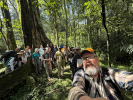Total Solar Eclipse
Solar eclipses 101
March 22, 2024
Share

An eclipse occurs whenever one astronomical object passes in front of another, blocking all or part of its light.
A-once-in-a-lifetime event is occurring on April 8 for a select group of North Americans within an area dubbed the "path of totality." This includes residents and tourists alike in Kingston who will be able to observe a total solar eclipse mid-afternoon that day. Preparations are underway to ensure members of the campus and local communities safely observe this phenomenon, from distributing certified eclipse glasses to outreach to area schools. Queen’s researchers are also contributing their expertise to help us unpack all angles of an eclipse – from its astronomical properties to its place in the history of science.
Judith Irwin (Physics, Engineering Physics, and Astronomy) is an astrophysicist and an expert in studying the interstellar medium in galaxies, the material that fills the space between the stars. By exploring the extensive gas, dust, magnetic fields, and cosmic rays in galaxies, we can learn more about how stars and related activity, like supernovae, interact with each other, and blow winds into intergalactic space.
Dr. Irwin recently sat down with the Queen’s Gazette to break down the properties of solar eclipses and explain their role in the study of astronomy.
– Total Solar Eclipse 2024

What is an eclipse, and can there be different types?
An eclipse occurs whenever one astronomical object passes in front of another, blocking all or part of its light.
There are different kinds, but not in any fundamental sense; it's just that if the moon passes in front of the Sun (this would be at New Moon), then it's called a solar eclipse. If the Earth passes between the Sun and the Moon (that would be at Full Moon), then it's called a lunar eclipse. If the entire Sun is blocked out, then it's a total solar eclipse; if only part of the Sun is blocked it is a partial eclipse.
This is the first solar eclipse over Kingston in about 700 years. Are eclipses this rare around the rest of the world or are there areas of the planet that experience them more often?
Eclipses, in general, are not actually rare. If you add up lunar, solar, total, and partial eclipses, there could be perhaps six or seven in any given year. But, if you put your finger on a map, at any given location, a total solar eclipse is indeed very rare, as Kingston’s number of 700 years attests. Furthermore, eclipses that be seen from land are also quite rare as most paths of totality fall over oceans.
This is just a matter of geometry. The solar eclipse shadow is small compared to the Earth's surface. Also, the difference between a partial and total solar eclipse is quite dramatic. Even if 95 per cent of the Sun is covered, you won't really notice a difference. But 100 per cent is breathtaking.
Why do we need to use solar filters in eyewear and camera lenses to view the Sun during an eclipse but not during any other day?
On any normal day, it is not possible to stare directly at the Sun. It hurts and you immediately look away. You could do the same thing with a partial solar eclipse. But, as more of the Sun is covered, you tend to be able to stare at the Sun without the same automatic reflex of needing to look away to protect your eyes. Yet, the sunlight from the uncovered part is just as bright as on a regular day and could therefore do damage to your eyes. Once the eclipse is total (about three minutes for us), then, you can safely remove your glasses to stare directly at it.

If you put your finger on a map, at any given location, a total solar eclipse is indeed very rare.
How does studying eclipses advance our understanding of astronomy?
The outermost part of the Sun’s atmosphere, the faint corona, usually hidden by the Sun’s brightness is really only visible (in optical light) during an eclipse. This is a very active region that is permeated with magnetic fields. We still don't know exactly how the corona is heated to its million-degree temperature – much hotter than the surface. Today we have telescopes that can cover up the disk of the Sun so that the corona can be studied regularly, creating an artificial eclipse, as it were.
How might the insights gained from studying our own galaxy during a solar eclipse contribute to our understanding of interstellar medium dynamics in other galaxies?
We don't normally study objects in our galaxy or other galaxies during an eclipse. It is better to observe such objects at night when darkness is maintained for longer periods of time. A famous scientific discovery, however, did occur in the year 1919. Astronomer Arthur Eddington and his team observed the locations of stars that were close to the limb, or curved edge, of the eclipsed Sun. Einstein's new General Theory of Relativity predicted a certain displacement due to starlight bending around the Sun enroute to the Earth. The measurements agreed with the prediction. This eclipse, in a sense, launched our new understanding of gravity, superseding the older Newtonian view.
This story is part of a series that will uncover the science behind the total solar eclipse that will be observed from Kingston on April 8, 2024. For more information and resources on the total solar eclipse, visit the Queen’s eclipse website.
Did you know that starting March 25 Queen’s is distributing certified eclipse glasses to the campus and Kingston community? Learn more about our distribution sites.



